Page path:
- Modern Dinocyst Key
- transparent cysts
- randomly distributed processes
- transparant cysts hollow processes
- Operculodinium israelianum
Operculodinium israelianum
Zonneveld, K.A.F. and Pospelova V. (2015). A determination key for modern dinoflagellate cysts. Palynology 39 (3), 387- 407.
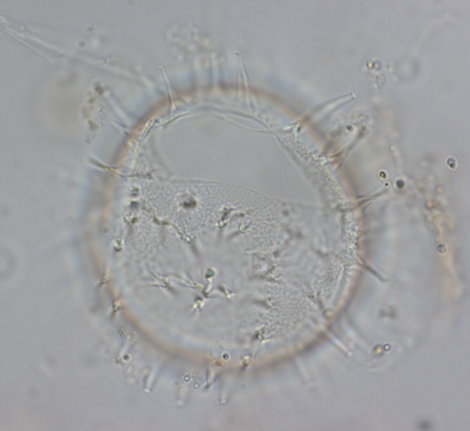
dorsal view
single grain - reference collection Bremen
Sample GeoB 12602-3 western Indian Ocean
photographs: Karin Zonneveld
single grain - reference collection Bremen
Sample GeoB 12602-3 western Indian Ocean
photographs: Karin Zonneveld
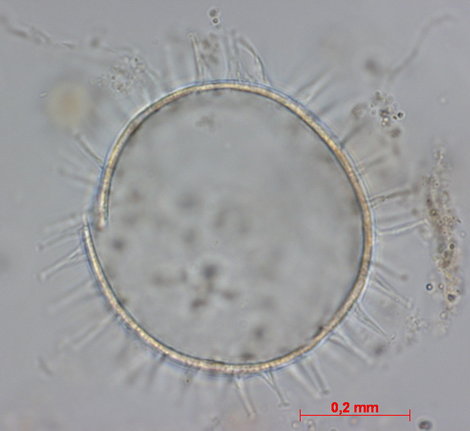
cross section
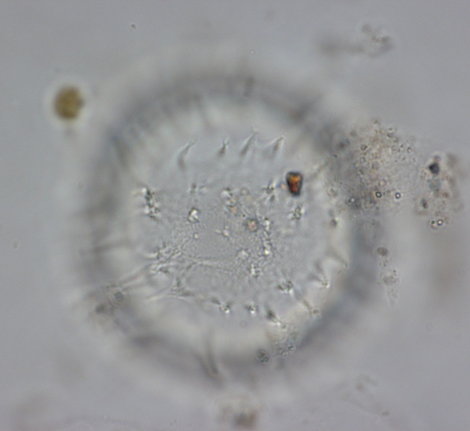
ventral view
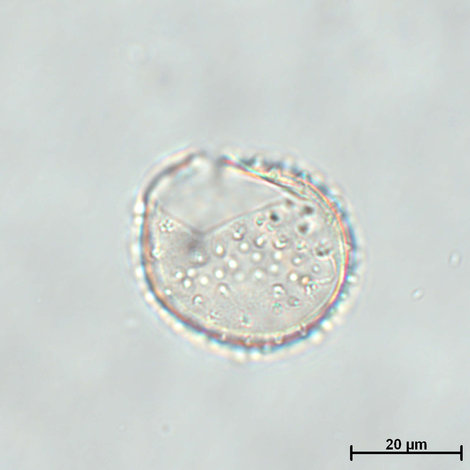
cyst with reduced processes
single grain - reference collection Bremen
Sample xxxxxxx
photographs: Karin Zonneveld
single grain - reference collection Bremen
Sample xxxxxxx
photographs: Karin Zonneveld
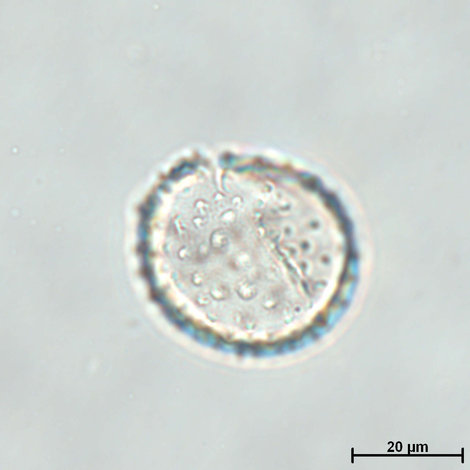
cyst with reduced processes
ventral view
ventral view
Field characteristics
Operculodinium israelianum (Rossignol 1962) Wall 1967
Field characteristics:
Chorate subspherical to ovoidal cyst. Relatively thick granular to fibro-pitted cyst wall. Nontabular hollow processes with acuminate distal tips. Proximal base of processes carries some striations. . Processes can be reduced in size. Tabulation is only indicated by a precingular archeopyle (type P).
Dimensions: Cyst body diameter 33 to 48 µm; length of processes 4 to 6 µm.
Motile affinity: Possibly Protoceratium (Claparède et Lachmann 1859) Bütschli 1885.
Stratigraphic range: Pleistocene to Recent.
Comparison with other species:
The discriminating characteristic of this species are the bases of its processes that bear characteristic striations. The processes have widened bases. Scanning electon microscopy has shown that these striae actually represent ruptures in the process-wall. This species can have reduced processes as well. The reduced processes are closed distally but the tapering process form and stria remain present.
Field characteristics:
Chorate subspherical to ovoidal cyst. Relatively thick granular to fibro-pitted cyst wall. Nontabular hollow processes with acuminate distal tips. Proximal base of processes carries some striations. . Processes can be reduced in size. Tabulation is only indicated by a precingular archeopyle (type P).
Dimensions: Cyst body diameter 33 to 48 µm; length of processes 4 to 6 µm.
Motile affinity: Possibly Protoceratium (Claparède et Lachmann 1859) Bütschli 1885.
Stratigraphic range: Pleistocene to Recent.
Comparison with other species:
The discriminating characteristic of this species are the bases of its processes that bear characteristic striations. The processes have widened bases. Scanning electon microscopy has shown that these striae actually represent ruptures in the process-wall. This species can have reduced processes as well. The reduced processes are closed distally but the tapering process form and stria remain present.
Geographic distribution
Geographic distribution based on :
Zonneveld et al., 2013. Atlas of modern dinoflagellate cyst distribution based on 2405 datapoints. Review of Palaeobotany and Palynology, v. 191, 1-197
Zonneveld et al., 2013. Atlas of modern dinoflagellate cyst distribution based on 2405 datapoints. Review of Palaeobotany and Palynology, v. 191, 1-197
Operculodinium israelianum can be regarded as a subtropical to equatorial species that can be observed in high relative abundances in nearshore sites and sites where high upper water salinities prevail.
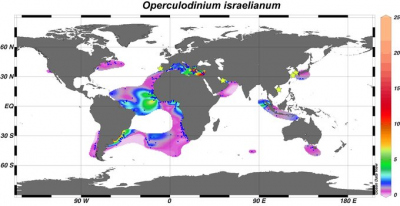
Distribution:
Operculodinium israelianum is restricted to subtropical, tropical and equatorial regions. It is abundant in coastal and open oceanic sites. Highest abundances (up to 20.3%) occur in the Eastern Mediterranean Sea notably off the Nile-river delta, in nearshore sites off northern Argentina/southern Brazil and in the nearshore central eastern Atlantic.
Environmental parameters:
SST: 1.8 - 29.8°C (winter - spring) with summer SST > 10°C except for three sites located south of South Africa. SSS: 30.3 - 39.4 (summer - autumn) except for one site near the coast of Argentina where SSS: 19.6 - 21.1 - 23.9 - 31.34 (spring - winter - summer - autumn). [P]: 0.06 - 1.67 μmol/l, [N]: 0.04 - 20.86 μmol/l, chlorophyll-a: 0.05 - 18.8 ml/l, [O2]: from 0.01 - 6.6 ml/l.
Operculodinium israelianum can be abundant in regions where SST > 28.8°C throughout the year. Abundances (> 10%) occur where SST: exceed 14.3°C in winter and 24.2°C in summer.
O. israelianum is restricted to full-marine regions. Highest relative abundances can be observed in regions where bottom waters are well ventilated.
Comparison with other records:
Apart from the sites included in this atlas Operculodinium israelianum is recorded from the SW Iberian margin (Sprangers et al., 2004), the Gulf of Oman and several sites from the southern coastal waters of Korea, the Yellow Sea and the East China Sea (Cho and Matsuoka, 2000; Cho et al., 2003; Marret and Zonneveld, 2003; Pospelova and Kim, 2010; Shin et al., 2007 and references therein). It can dominate assemblages in high salinity environments such as shallow lagoons in sub-tropical - tropical regions (Bradford and Wall, 1984; Morzadec-Kerfourn et al., 1990) Sediment trap and seasonal distribution studies do not reveal a seasonal pattern in the cyst production of O. israelianum (Susek et al., 2005; Ribeiro and Amorim, 2008; Zonneveld et al., 2010)
Operculodinium israelianum is restricted to subtropical, tropical and equatorial regions. It is abundant in coastal and open oceanic sites. Highest abundances (up to 20.3%) occur in the Eastern Mediterranean Sea notably off the Nile-river delta, in nearshore sites off northern Argentina/southern Brazil and in the nearshore central eastern Atlantic.
Environmental parameters:
SST: 1.8 - 29.8°C (winter - spring) with summer SST > 10°C except for three sites located south of South Africa. SSS: 30.3 - 39.4 (summer - autumn) except for one site near the coast of Argentina where SSS: 19.6 - 21.1 - 23.9 - 31.34 (spring - winter - summer - autumn). [P]: 0.06 - 1.67 μmol/l, [N]: 0.04 - 20.86 μmol/l, chlorophyll-a: 0.05 - 18.8 ml/l, [O2]: from 0.01 - 6.6 ml/l.
Operculodinium israelianum can be abundant in regions where SST > 28.8°C throughout the year. Abundances (> 10%) occur where SST: exceed 14.3°C in winter and 24.2°C in summer.
O. israelianum is restricted to full-marine regions. Highest relative abundances can be observed in regions where bottom waters are well ventilated.
Comparison with other records:
Apart from the sites included in this atlas Operculodinium israelianum is recorded from the SW Iberian margin (Sprangers et al., 2004), the Gulf of Oman and several sites from the southern coastal waters of Korea, the Yellow Sea and the East China Sea (Cho and Matsuoka, 2000; Cho et al., 2003; Marret and Zonneveld, 2003; Pospelova and Kim, 2010; Shin et al., 2007 and references therein). It can dominate assemblages in high salinity environments such as shallow lagoons in sub-tropical - tropical regions (Bradford and Wall, 1984; Morzadec-Kerfourn et al., 1990) Sediment trap and seasonal distribution studies do not reveal a seasonal pattern in the cyst production of O. israelianum (Susek et al., 2005; Ribeiro and Amorim, 2008; Zonneveld et al., 2010)


